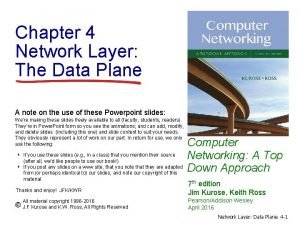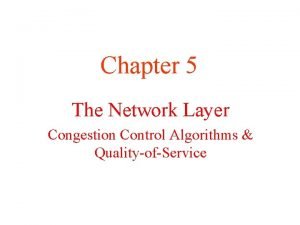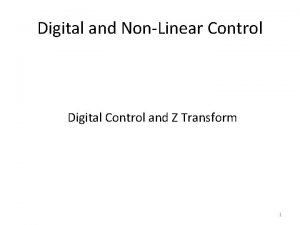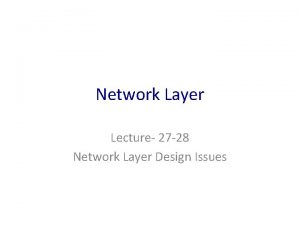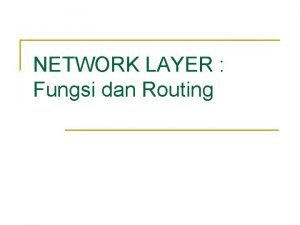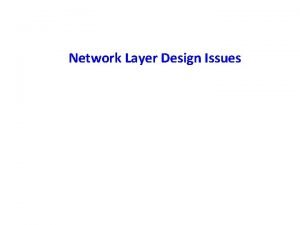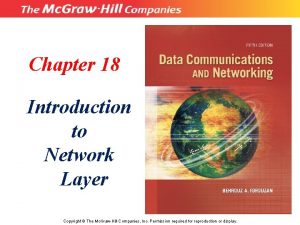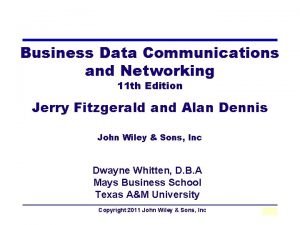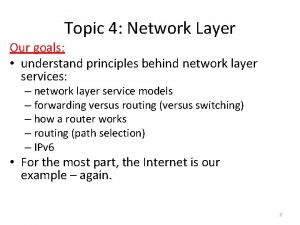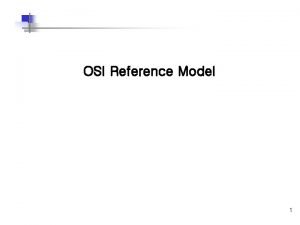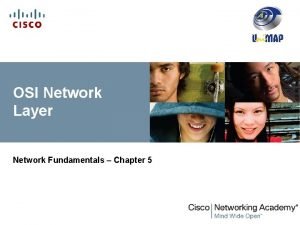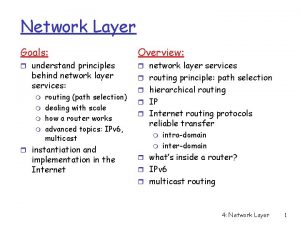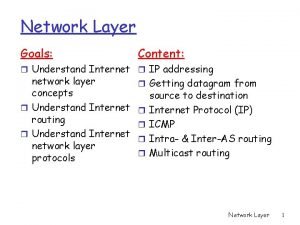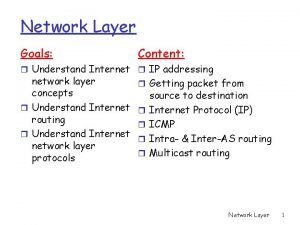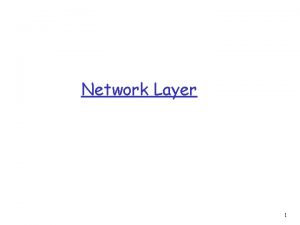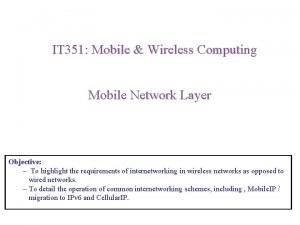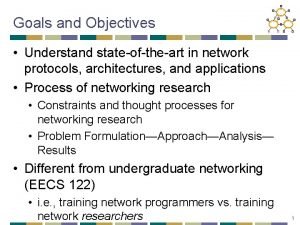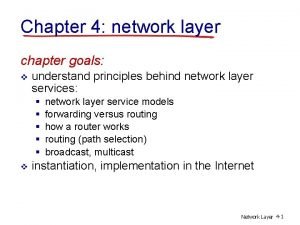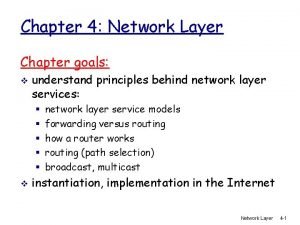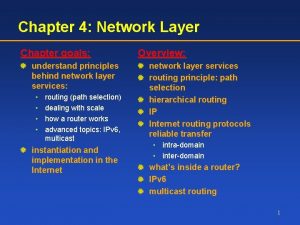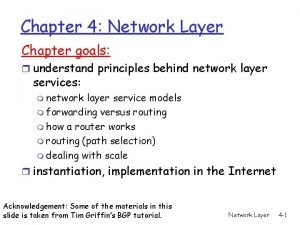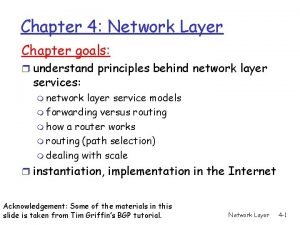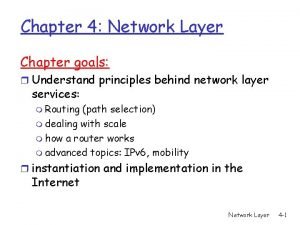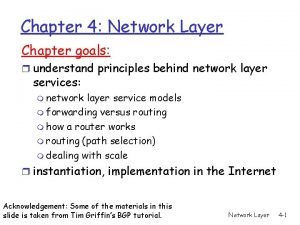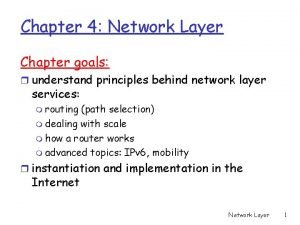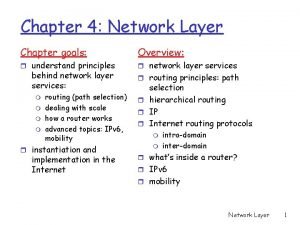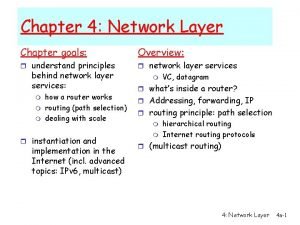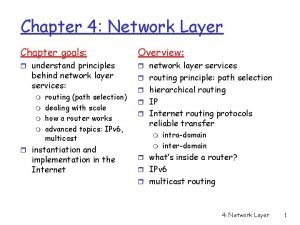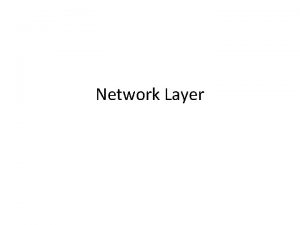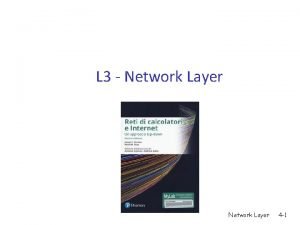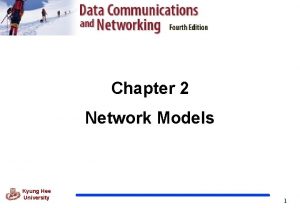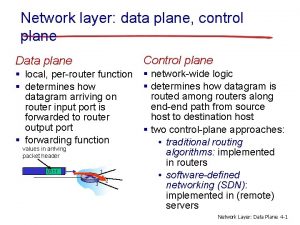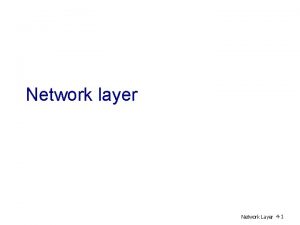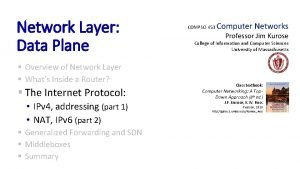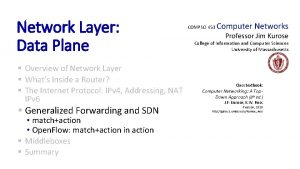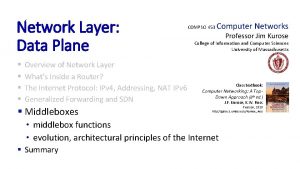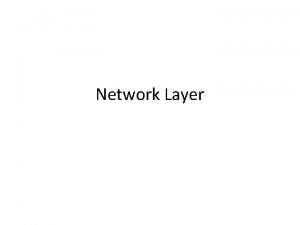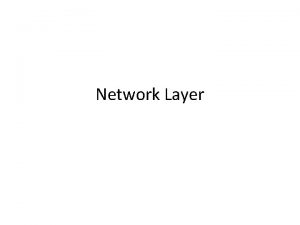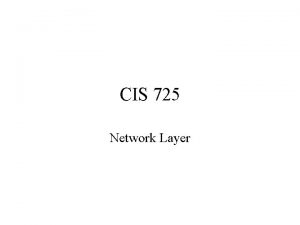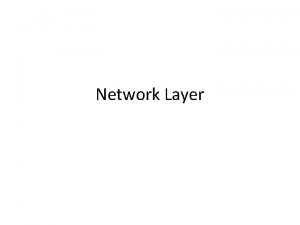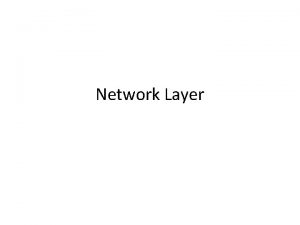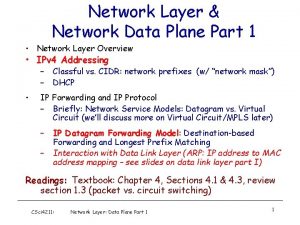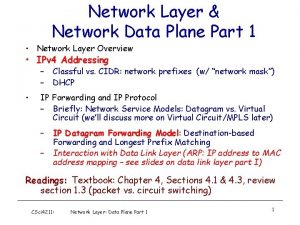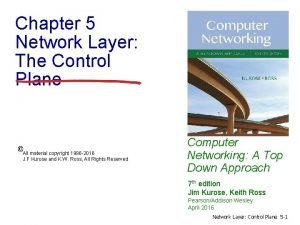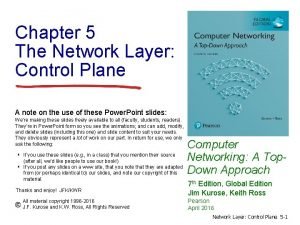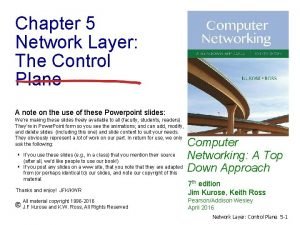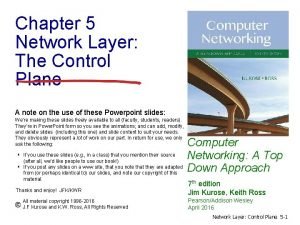Chapter 5 Network Layer The Control Plane A
















































- Slides: 48

Chapter 5 Network Layer: The Control Plane A note on the use of these Powerpoint slides: We’re making these slides freely available to all (faculty, students, readers). They’re in Power. Point form so you see the animations; and can add, modify, and delete slides (including this one) and slide content to suit your needs. They obviously represent a lot of work on our part. In return for use, we only ask the following: § If you use these slides (e. g. , in a class) that you mention their source (after all, we’d like people to use our book!) § If you post any slides on a www site, that you note that they are adapted from (or perhaps identical to) our slides, and note our copyright of this material. Thanks and enjoy! JFK/KWR All material copyright 1996 -2016 J. F Kurose and K. W. Ross, All Rights Reserved Computer Networking: A Top Down Approach 7 th edition Jim Kurose, Keith Ross Pearson/Addison Wesley April 2016 Network Layer: Control Plane 5 -1

Chapter 5: outline 5. 1 introduction 5. 2 routing protocols § link state § distance vector 5. 3 intra-AS routing in the Internet: OSPF 5. 4 routing among the ISPs: BGP 5. 5 The SDN control plane 5. 6 ICMP: The Internet Control Message Protocol 5. 7 Network management and SNMP Network Layer: Control Plane 5 -2

Internet inter-AS routing: BGP § BGP (Border Gateway Protocol): the de facto inter-domain routing protocol • “glue that holds the Internet together” § BGP provides each AS a means to: • e. BGP: obtain subnet reachability information from neighboring ASes • i. BGP: propagate reachability information to all AS-internal routers. • determine “good” routes to other networks based on reachability information and policy § allows subnet to advertise its existence to rest of Internet: “I am here” Network Layer: Control Plane 5 -3

e. BGP, i. BGP connections 2 b 2 a 1 b 1 a 1 c 2 d AS 2 1 d AS 1 1 c 2 c ∂ e. BGP connectivity i. BGP connectivity 3 b ∂ 3 a 3 c 3 d AS 3 gateway routers run both e. BGP and i. BGP protools Network Layer: Control Plane 5 -4

BGP basics § BGP session: two BGP routers (“peers”) exchange BGP messages over semi-permanent TCP connection: • advertising paths to different destination network prefixes (BGP is a “path vector” protocol) § when AS 3 gateway router 3 a advertises path AS 3, X to AS 2 gateway router 2 c: • AS 3 promises to AS 2 it will forward datagrams towards X AS 1 AS 3 1 b 1 a 3 b 3 a 1 c AS 2 1 d 2 b 2 a 3 d 2 c 2 d 3 c X BGP advertisement: AS 3, X Network Layer: Control Plane 5 -5

Path attributes and BGP routes § advertised prefix includes BGP attributes • prefix + attributes = “route” § two important attributes: • AS-PATH: list of ASes through which prefix advertisement has passed • NEXT-HOP: indicates specific internal-AS router to next-hop AS § Policy-based routing: • gateway receiving route advertisement uses import policy to accept/decline path (e. g. , never route through AS Y). • AS policy also determines whether to advertise path to other neighboring ASes Network Layer: Control Plane 5 -6

BGP path advertisement AS 1 AS 3 1 b 1 a 3 a 1 c AS 2 1 d AS 2, AS 3, X 3 b 2 b 2 a 3 c AS 3, X 3 d X 2 c 2 d § AS 2 router 2 c receives path advertisement AS 3, X (via e. BGP) from AS 3 router 3 a § Based on AS 2 policy, AS 2 router 2 c accepts path AS 3, X, propagates (via i. BGP) to all AS 2 routers § Based on AS 2 policy, AS 2 router 2 a advertises (via e. BGP) path AS 2, AS 3, X to AS 1 router 1 c Network Layer: Control Plane 5 -7

BGP path advertisement AS 1 1 b 1 a AS 3, X 3 b 3 a 1 c AS 2 1 d AS 2, AS 3, X AS 3 2 b 2 a 3 c AS 3, X 3 d X 2 c 2 d gateway router may learn about multiple paths to destination: § AS 1 gateway router 1 c learns path AS 2, AS 3, X from 2 a § AS 1 gateway router 1 c learns path AS 3, X from 3 a § Based on policy, AS 1 gateway router 1 c chooses path AS 3, X, and advertises path within AS 1 via i. BGP Network Layer: Control Plane 5 -8

BGP messages § BGP messages exchanged between peers over TCP connection § BGP messages: • OPEN: opens TCP connection to remote BGP peer and authenticates sending BGP peer • UPDATE: advertises new path (or withdraws old) • KEEPALIVE: keeps connection alive in absence of UPDATES; also ACKs OPEN request • NOTIFICATION: reports errors in previous msg; also used to close connection Network Layer: Control Plane 5 -9

BGP, OSPF, forwarding table entries Q: how does router set forwarding table entry to distant prefix? AS 1 1 b 1 1 a 2 AS 3, X 3 b 3 a 1 c local link interfaces 2 1 d 1 at 1 a, 1 d AS 2, AS 3, X AS 3 AS 2 2 b 2 a 3 c AS 3, X X 3 d 2 c physical link 2 d dest interface … … X 1 … … § recall: 1 a, 1 b, 1 c learn about dest X via i. BGP from 1 c: “path to X goes through § 1 c” 1 d: OSPF intra-domain routing: to get to 1 c, forward over outgoing local interface 1 Network Layer: Control Plane 5 -10

BGP, OSPF, forwarding table entries Q: how does router set forwarding table entry to distant prefix? AS 1 AS 3 1 b 1 1 a 3 a 1 c 2 3 b AS 2 1 d 2 b 2 a 3 c 3 d X 2 c 2 d dest interface … … X 2 … … § recall: 1 a, 1 b, 1 c learn about dest X via i. BGP from 1 c: “path to X goes through § 1 c” 1 d: OSPF intra-domain routing: to get to 1 c, forward over outgoing local interface 1 § 1 a: OSPF intra-domain routing: to get to 1 c, forward over outgoing local interface 2 Network Layer: Control Plane 5 -11

BGP route selection § router may learn about more than one route to destination AS, selects route based on: 1. 2. 3. 4. local preference value attribute: policy decision shortest AS-PATH closest NEXT-HOP router: hot potato routing additional criteria Network Layer: Control Plane 5 -12

Hot Potato Routing AS 1 AS 3 1 b 1 a 3 a 1 c AS 2 2 b 1 d AS 1, AS 3, X 3 b 2 a 152 263 201 2 d 112 3 c 3 d X AS 3, X 2 c OSPF link weights § 2 d learns (via i. BGP) it can route to X via 2 a or 2 c § hot potato routing: choose local gateway that has least intra-domain cost (e. g. , 2 d chooses 2 a, even though more AS hops to X): don’t worry about inter-domain cost! Network Layer: Control Plane 5 -13

BGP: achieving policy via advertisements legend: B W provider network X A customer network: C Y Suppose an ISP only wants to route traffic to/from its customer networks (does not want to carry transit traffic between other ISPs) § A advertises path Aw to B and to C § B chooses not to advertise BAw to C: § B gets no “revenue” for routing CBAw, since none of C, A, w are B’s customers § C does not learn about CBAw path § C will route CAw (not using B) to get to w Network Layer: Control Plane 5 -14

BGP: achieving policy via advertisements legend: B W provider network X A customer network: C Y Suppose an ISP only wants to route traffic to/from its customer networks (does not want to carry transit traffic between other ISPs) § A, B, C are provider networks § X, W, Y are customer (of provider networks) § X is dual-homed: attached to two networks § policy to enforce: X does not want to route from B to C via X §. . so X will not advertise to B a route to C Network Layer: Control Plane 5 -15

Why different Intra-, Inter-AS routing ? policy: § inter-AS: admin wants control over how its traffic routed, who routes through its net. § intra-AS: single admin, so no policy decisions needed scale: § hierarchical routing saves table size, reduced update traffic performance: § intra-AS: can focus on performance § inter-AS: policy may dominate over performance Network Layer: Control Plane 5 -16

Chapter 5: outline 5. 1 introduction 5. 2 routing protocols § link state § distance vector 5. 3 intra-AS routing in the Internet: OSPF 5. 4 routing among the ISPs: BGP 5. 5 The SDN control plane 5. 6 ICMP: The Internet Control Message Protocol 5. 7 Network management and SNMP Network Layer: Control Plane 5 -17

Software defined networking (SDN) § Internet network layer: historically has been implemented via distributed, per-router approach • monolithic router contains switching hardware, runs proprietary implementation of Internet standard protocols (IP, RIP, IS-IS, OSPF, BGP) in proprietary router OS (e. g. , Cisco IOS) • different “middleboxes” for different network layer functions: firewalls, load balancers, NAT boxes, . . § ~2005: renewed interest in rethinking network control plane Network Layer: Control Plane 5 -18

Recall: per-router control plane Individual routing algorithm components in each and every router interact with each other in control plane to compute forwarding tables Routing Algorithm control plane data plane Network Layer: Control Plane 5 -19

Recall: logically centralized control plane A distinct (typically remote) controller interacts with local control agents (CAs) in routers to compute forwarding tables Remote Controller control plane data plane CA CA CA Network Layer: Control Plane 5 -20

Software defined networking (SDN) Why a logically centralized control plane? § easier network management: avoid router misconfigurations, greater flexibility of traffic flows § table-based forwarding (recall Open. Flow API) allows “programming” routers • centralized “programming” easier: compute tables centrally and distribute • distributed “programming: more difficult: compute tables as result of distributed algorithm (protocol) implemented in each and every router § open (non-proprietary) implementation of control plane Network Layer: Control Plane 5 -21

Analogy: mainframe to PC evolution Specialized Applications Specialized Operating System Specialized Hardware Vertically integrated Closed, proprietary Slow innovation Small industry * Slide courtesy: N. Mc. Keown * Ap Ap Ap p p App Open Interface Windows (OS) or Linux or Mac OS Open Interface Microprocessor Horizontal Open interfaces Rapid innovation Huge industry Network Layer: Control Plane 5 -22

Traffic engineering: difficult traditional routing 5 2 v u 3 2 1 x w 3 1 5 1 y z 2 Q: what if network operator wants u-to-z traffic to flow along uvwz, x-to-z traffic to flow xwyz? A: need to define link weights so traffic routing algorithm computes routes accordingly (or need a new routing algorithm)! Link weights are only control “knobs”: wrong! Network Layer: Control Plane 5 -23

Traffic engineering: difficult 5 2 v u 3 2 1 x w 3 1 5 1 y z 2 Q: what if network operator wants to split u-to-z traffic along uvwz and uxyz (load balancing)? A: can’t do it (or need a new routing algorithm) Network Layer: Control Plane 5 -24

Networking 401 Traffic engineering: difficult 5 2 3 v v 2 u 1 xx w w zz 1 3 1 5 yy 2 Q: what if w wants to route blue and red traffic differently? A: can’t do it (with destination based forwarding, and LS, DV routing) Network Layer: Control Plane 5 -25

Software defined networking (SDN) 4. programmable control applications routing … access control 3. control plane functions external to dataplane switches load balance Remote Controller control plane data plane CA CA CA 2. control, data plane separation 1: generalized“ flowbased” forwarding (e. g. , Open. Flow) Network Layer: Control Plane 5 -26

SDN perspective: data plane switches Data plane switches § fast, simple, commodity switches implementing generalized data-plane forwarding (Section 4. 4) in hardware § switch flow table computed, installed by controller § API for table-based switch control (e. g. , Open. Flow) • defines what is controllable and what is not network-control applications … routing access control load balance northbound API SDN Controller (network operating system) southbound API § protocol for communicating with controller (e. g. , Open. Flow) Network Layer: Control Plane 5 -27 control plane data plane SDN-controlled switches

SDN perspective: SDN controller (network OS): § maintain network state information § interacts with network control applications “above” via northbound API § interacts with network switches “below” via southbound API § implemented as distributed system for performance, scalability, fault-tolerance, robustness Network Layer: Control Plane 5 -28 network-control applications … routing access control load balance northbound API control plane SDN Controller (network operating system) southbound API data plane SDN-controlled switches

SDN perspective: control applications network-control apps: § “brains” of control: implement control functions using lower-level services, API provided by SND controller § unbundled: can be provided by 3 rd party: distinct from routing vendor, or SDN controller network-control applications … routing access control load balance northbound API control plane SDN Controller (network operating system) southbound API data plane Network Layer: Control Plane 5 -29 SDN-controlled switches

Components of SDN controller access control routing Interface layer to network control apps: abstractions API Network-wide state management layer: state of networks links, switches, services: a distributed database communication layer: communicate between SDN controller and controlled switches load balance Interface, abstractions for network control apps network graph RESTful API statistics … … intent flow tables Network-wide distributed, robust state management Link-state info host info Open. Flow … … switch info SDN controller SNMP Communication to/from controlled devices Network Layer: Control Plane 5 -30

Open. Flow protocol Open. Flow Controller § operates between controller, switch § TCP used to exchange messages • optional encryption § three classes of Open. Flow messages: • controller-to-switch • asynchronous (switch to controller) • symmetric (misc) Network Layer: Control Plane 5 -31

Open. Flow: controller-to-switch messages Key controller-to-switch messages § features: controller queries switch features, switch replies § configure: controller queries/sets switch configuration parameters § modify-state: add, delete, modify flow entries in the Open. Flow tables § packet-out: controller can send this packet out of Open. Flow Controller Network Layer: Control Plane 5 -32

Open. Flow: switch-to-controller messages Key switch-to-controller messages § packet-in: transfer packet (and its control) to controller. See packet-out message from controller § flow-removed: flow table entry deleted at switch § port status: inform controller of a change on a port. Open. Flow Controller Fortunately, network operators don’t “program” switches by creating/sending Open. Flow messages directly. Instead use higher-level abstraction at controller Network Layer: Control Plane 5 -33

SDN: control/data plane interaction example 1 S 1, experiencing link failure using Open. Flow port status message to notify controller Dijkstra’s link-state Routing 4 network graph RESTful API … 3 statistics Link-state info host info 2 … Open. Flow 1 5 … flow tables … 2 SDN controller receives Open. Flow message, updates link status info 3 Dijkstra’s routing algorithm application has previously registered to be called when ever link status changes. It is called. 4 Dijkstra’s routing algorithm access network graph info, link state info in controller, computes new routes s 2 s 3 switch info SNMP 6 s 1 intent s 4 Network Layer: Control Plane 5 -34

SDN: control/data plane interaction example Dijkstra’s link-state Routing 4 network graph RESTful API … 3 statistics Link-state info host info 2 … Open. Flow 1 5 … intent flow tables … switch info SNMP 5 link state routing app interacts with flow-tablecomputation component in SDN controller, which computes new flow tables needed 6 Controller uses Open. Flow to install new tables in switches that need updating 6 s 2 s 1 s 3 s 4 Network Layer: Control Plane 5 -35

Open. Daylight (ODL) controller … Traffic Engineering REST API Network service apps Access Control Basic Network Service Functions topology manager switch manager forwarding manager stats manager host manager Service Abstraction Layer (SAL) Open. Flow 1. 0 … SNMP OVSDB § ODL Lithium controller § network apps may be contained within, or be external to SDN controller § Service Abstraction Layer: interconnects internal, external applications and services Network Layer: Control Plane 5 -36

ONOS controller … Network control apps REST API Intent northbound abstractions, protocols hosts paths flow rules topology devices links statistics ONOS distributed core host flow packet device link Open. Flow Netconf OVSDB southbound abstractions, protocols § control apps separate from controller § intent framework: high-level specification of service: what rather than how § considerable emphasis on distributed core: service reliability, replication performance scaling Network Layer: Control Plane 5 -37

SDN: selected challenges § hardening the control plane: dependable, reliable, performance-scalable, secure distributed system • robustness to failures: leverage strong theory of reliable distributed system for control plane • dependability, security: “baked in” from day one? § networks, protocols meeting mission-specific requirements • e. g. , real-time, ultra-reliable, ultra-secure § Internet-scaling Network Layer: Control Plane 5 -38

Chapter 5: outline 5. 1 introduction 5. 2 routing protocols § link state § distance vector 5. 3 intra-AS routing in the Internet: OSPF 5. 4 routing among the ISPs: BGP 5. 5 The SDN control plane 5. 6 ICMP: The Internet Control Message Protocol 5. 7 Network management and SNMP Network Layer: Control Plane 5 -39

ICMP: internet control message protocol § used by hosts & routers to communicate network -level information • error reporting: unreachable host, network, port, protocol • echo request/reply (used by ping) § network-layer “above” IP: • ICMP msgs carried in IP datagrams § ICMP message: type, code plus first 8 bytes of IP datagram causing error Type 0 3 3 3 4 Code 0 0 1 2 3 6 7 0 8 9 10 11 12 0 0 0 description echo reply (ping) dest. network unreachable dest host unreachable dest protocol unreachable dest port unreachable dest network unknown dest host unknown source quench (congestion control - not used) echo request (ping) route advertisement router discovery TTL expired bad IP header Network Layer: Control Plane 5 -40

Traceroute and ICMP § source sends series of UDP segments to destination • first set has TTL =1 • second set has TTL=2, etc. • unlikely port number § when datagram in nth set arrives to nth router: • router discards datagram and sends source ICMP message (type 11, code 0) • ICMP message include name of router & IP address 3 probes § when ICMP message arrives, source records RTTs stopping criteria: § UDP segment eventually arrives at destination host § destination returns ICMP “port unreachable” message (type 3, code 3) § source stops 3 probes Network Layer: Control Plane 5 -41

Chapter 5: outline 5. 1 introduction 5. 2 routing protocols § link state § distance vector 5. 3 intra-AS routing in the Internet: OSPF 5. 4 routing among the ISPs: BGP 5. 5 The SDN control plane 5. 6 ICMP: The Internet Control Message Protocol 5. 7 Network management and SNMP Network Layer: Control Plane 5 -42

What is network management? § autonomous systems (aka “network”): 1000 s of interacting hardware/software components § other complex systems requiring monitoring, control: • jet airplane • nuclear power plant • others? "Network management includes the deployment, integration and coordination of the hardware, software, and human elements to monitor, test, poll, configure, analyze, evaluate, and control the network and element resources to meet the real-time, operational performance, and Quality of Service requirements at a reasonable cost. " Network Layer: Control Plane 5 -43

Infrastructure for network management definitions: managing entity agent data network management protocol managed device agent data managed devices contain managed objects whose data is gathered into a Management Information Base (MIB) agent data managed device Network Layer: Control Plane 5 -44

SNMP protocol Two ways to convey MIB info, commands: managing entity request trap msg response agent data managed device request/response mode agent data managed device trap mode Network Layer: Control Plane 5 -45

SNMP protocol: message types Message type Get. Request Get. Next. Request Get. Bulk. Request Inform. Request Set. Request Response Trap Function manager-to-agent: “get me data” (data instance, next data in list, block of data) manager-to-manager: here’s MIB value manager-to-agent: set MIB value Agent-to-manager: value, response to Request Agent-to-manager: inform manager of exceptional event Network Layer: Control Plane 5 -46

SNMP protocol: message formats Variables to get/set Get/set header PDU Error Request type Status ID (0 -3) (0 -5) Error Name Value …. Index PDU Trap Agent type Enterprise Type Addr 4 (0 -7) Specific Time Name Value …. code stamp Trap header Trap info SNMP PDU More on network management: see earlier editions of text! Network Layer: Control Plane 5 -47

Chapter 5: summary we’ve learned a lot! § approaches to network control plane • per-router control (traditional) • logically centralized control (software defined networking) § traditional routing algorithms • implementation in Internet: OSPF, BGP § SDN controllers • implementation in practice: ODL, ONOS § Internet Control Message Protocol § network management next stop: link layer! Network Layer: Control Plane 5 -48
 Data plane control plane and management plane
Data plane control plane and management plane Network layer data plane
Network layer data plane Forwarding equivalence class (fec)
Forwarding equivalence class (fec) Congestion control in network layer
Congestion control in network layer Fig 19
Fig 19 How are glands classified
How are glands classified Secure socket layer and transport layer security
Secure socket layer and transport layer security Layer 6 presentation layer
Layer 6 presentation layer Secure socket layer and transport layer security
Secure socket layer and transport layer security Secure socket layer and transport layer security
Secure socket layer and transport layer security Secure socket layer and transport layer security
Secure socket layer and transport layer security Layer 2 e layer 3
Layer 2 e layer 3 Layer-by-layer assembly
Layer-by-layer assembly Layer 2 vs layer 3 bitstream
Layer 2 vs layer 3 bitstream Z transform is a non-linear function
Z transform is a non-linear function 체적변형률
체적변형률 Network layer design
Network layer design Comparison of virtual circuit and datagram subnets
Comparison of virtual circuit and datagram subnets Fungsi dari network layer
Fungsi dari network layer Network layer design issues
Network layer design issues Introduction to network layer
Introduction to network layer 5 layer network model
5 layer network model Two layer network
Two layer network Goals of network layer
Goals of network layer What is osi model explain?
What is osi model explain? Goals of network layer
Goals of network layer Goals of network layer
Goals of network layer Goals of network layer
Goals of network layer Goals of network layer
Goals of network layer Goals of network layer
Goals of network layer Mobile network layer
Mobile network layer Networking goals and objectives
Networking goals and objectives Goals of network layer
Goals of network layer Goals of network layer
Goals of network layer Goals of network layer
Goals of network layer Goals of network layer
Goals of network layer Goals of network layer
Goals of network layer Goals of network layer
Goals of network layer Goals of network layer
Goals of network layer Isps-r-us
Isps-r-us Goals of network layer
Goals of network layer Goals of network layer
Goals of network layer Goals of network layer
Goals of network layer Path determination in network layer
Path determination in network layer Network layer 4
Network layer 4 Network layer design issues
Network layer design issues Network layer
Network layer Osi layer ftp
Osi layer ftp Network layer in osi model
Network layer in osi model

